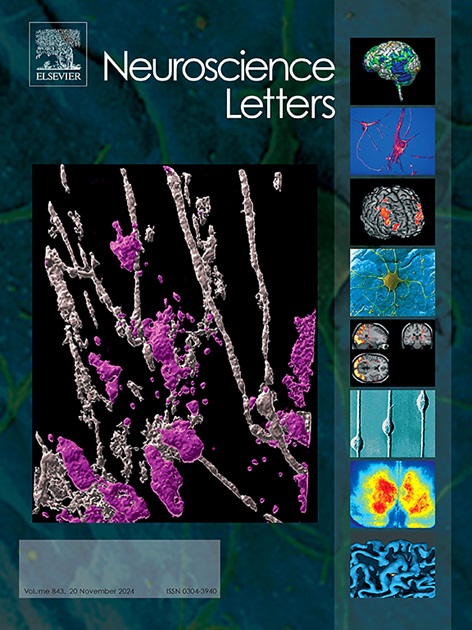经颅阳极直流电刺激小脑通过减少乙酰胆碱的释放来缓解晕动病。
IF 2.5
4区 医学
Q3 NEUROSCIENCES
引用次数: 0
摘要
晕动病(MS)是一种由运动传感器与过去的视觉或运动记忆发生冲突引起的疾病,会导致运动减退、体温低、食欲不振和恶心等不适症状。既往研究表明,小脑与多发性硬化症的发生密切相关。本研究旨在探讨经颅直流电刺激(tDCS)对多发性硬化症的潜在治疗作用,采用晕动病指数和rotarod运动性能测试评估小鼠的晕动病症状和运动学习。结果表明,tDCS能有效降低旋转诱导的MS小鼠的晕动病指数,并能逆转旋转诱导的旋转运动学习障碍。为了了解潜在的潜在机制,我们使用双光子微成像来监测小脑中乙酰胆碱的释放。我们的结果显示旋转后小脑乙酰胆碱释放显著增加。此外,阳极tDCS (a-tDCS)不仅可以抵消旋转诱导的MS小鼠乙酰胆碱升高,还可以降低静态对照小鼠乙酰胆碱水平。综上所述,这些发现表明,阳极经颅直流电刺激减轻了与晕车相关的症状,这可能与小脑乙酰胆碱释放减少有关。本文章由计算机程序翻译,如有差异,请以英文原文为准。
Anodal transcranial direct current stimulation of cerebellum relieves motion sickness by reducing the release of acetylcholine
Motion sickness (MS) is a condition caused by conflicts between motion sensors and past visual or motion memories, leading to discomfort with symptoms like hypolocomotion, low body temperature, poor appetite, and nausea. Previous studies have shown that the cerebellum is closely related to the occurrence of MS. In the present study, we aimed to evaluate the potential therapeutic effects of transcranial direct current stimulation (tDCS) of cerebellum on MS. The motion sickness index and the rotarod motor performance test were used to assess the motion sickness symptoms and motor learning in mice. Our results showed that tDCS was effective in reducing the motion sickness index in rotation-induced MS mice, as well as in reversing the rotation-induced impairment in rotarod motor learning. To understand the potential underlying mechanism, we used two-photon microimaging to monitor the release of acetylcholine in the cerebellum. Our results showed a significant increase in acetylcholine release in the cerebellum after rotation. Furthermore, anodal tDCS (a-tDCS) not only counteracted rotation-induced increase of acetylcholine in MS mice but also reduced the level of acetylcholine in static control mice. Together, these findings indicate that anodal transcranial direct current stimulation alleviates symptoms associated with motion sickness, which may be related to the reduction of acetylcholine release in the cerebellum.
求助全文
通过发布文献求助,成功后即可免费获取论文全文。
去求助
来源期刊

Neuroscience Letters
医学-神经科学
CiteScore
5.20
自引率
0.00%
发文量
408
审稿时长
50 days
期刊介绍:
Neuroscience Letters is devoted to the rapid publication of short, high-quality papers of interest to the broad community of neuroscientists. Only papers which will make a significant addition to the literature in the field will be published. Papers in all areas of neuroscience - molecular, cellular, developmental, systems, behavioral and cognitive, as well as computational - will be considered for publication. Submission of laboratory investigations that shed light on disease mechanisms is encouraged. Special Issues, edited by Guest Editors to cover new and rapidly-moving areas, will include invited mini-reviews. Occasional mini-reviews in especially timely areas will be considered for publication, without invitation, outside of Special Issues; these un-solicited mini-reviews can be submitted without invitation but must be of very high quality. Clinical studies will also be published if they provide new information about organization or actions of the nervous system, or provide new insights into the neurobiology of disease. NSL does not publish case reports.
 求助内容:
求助内容: 应助结果提醒方式:
应助结果提醒方式:


